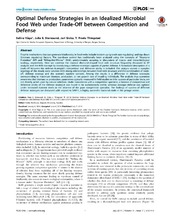| dc.contributor.author | Våge, Selina | eng |
| dc.contributor.author | Storesund, Julia Endresen | eng |
| dc.contributor.author | Giske, Jarl | eng |
| dc.contributor.author | Thingstad, Tron Frede | eng |
| dc.date.accessioned | 2014-12-23T07:40:31Z | |
| dc.date.available | 2014-12-23T07:40:31Z | |
| dc.date.issued | 2014-07-07 | eng |
| dc.identifier.issn | 1932-6203 | en_US |
| dc.identifier.uri | http://hdl.handle.net/1956/9018 | |
| dc.description.abstract | Trophic mechanisms that can generate biodiversity in food webs include bottom-up (growth rate regulating) and top-down (biomass regulating) factors. The top-down control has traditionally been analyzed using the concepts of “Keystone Predation” (KP) and “Killing-the-Winner” (KtW), predominately occuring in discussions of macro- and micro-biological ecology, respectively. Here we combine the classical diamond-shaped food web structure frequently discussed in KP analyses and the KtW concept by introducing a defense strategist capable of partial defense. A formalized description of a trade-off between the defense-strategist's competitive and defensive ability is included. The analysis reveals a complex topology of the steady state solution with strong relationships between food web structure and the combination of trade-off, defense strategy and the system's nutrient content. Among the results is a difference in defense strategies corresponding to maximum biomass, production, or net growth rate of invading individuals. The analysis thus summons awareness that biomass or production, parameters typically measured in field studies to infer success of particular biota, are not directly acted upon by natural selection. Under coexistence with a competition specialist, a balance of competitive and defensive ability of the defense strategist was found to be evolutionarily stable, whereas stronger defense was optimal under increased nutrient levels in the absence of the pure competition specialist. The findings of success of different defense strategies are discussed with respect to SAR11, a highly successful bacterial clade in the pelagic ocean. | en_US |
| dc.language.iso | eng | eng |
| dc.publisher | PLoS | en_US |
| dc.rights | Attribution CC BY | eng |
| dc.rights.uri | http://creativecommons.org/licenses/by/4.0/ | eng |
| dc.title | Optimal defense strategies in an idealized microbial food web under trade-off between competition and defense | en_US |
| dc.type | Peer reviewed | |
| dc.type | Journal article | |
| dc.date.updated | 2014-12-23T07:37:00Z | |
| dc.description.version | publishedVersion | en_US |
| dc.rights.holder | Copyright 2014 Våge et al | en_US |
| dc.source.articlenumber | e101415 | |
| dc.identifier.doi | https://doi.org/10.1371/journal.pone.0101415 | |
| dc.identifier.cristin | 1164357 | |
| dc.source.journal | PLoS ONE | |
| dc.source.40 | 9 | |
| dc.source.14 | 7 | |

